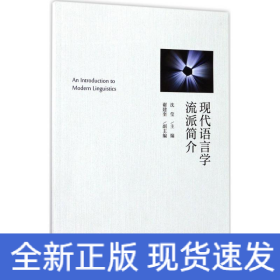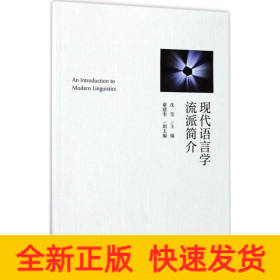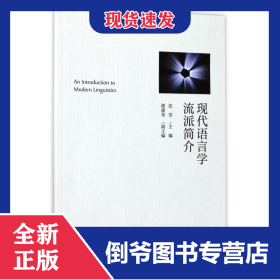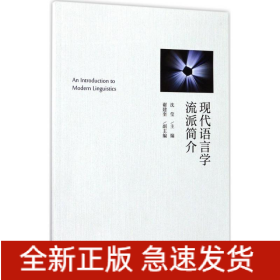
现代语言学流派简介
本店所售图书,保证正版新书,有个别图片和实书封面不一样,以实书封面为准,最快当天,一般隔天发货。支持7天无理由退换货.开票联系客服
¥ 5.49 3.1折 ¥ 18 全新
仅1件
北京西城
认证卖家担保交易快速发货售后保障
作者沈莹
出版社浙江大学出版社
出版时间2017-08
版次1
装帧其他
货号3899641
上书时间2023-12-15
- 最新上架
商品详情
- 品相描述:全新
- 商品描述
-
目录
Chapter 1 Introduction
1.1 Notion of Language
1.2 Design Features of Language
1.3 Notion of Linguistics
1.4 Differences Between Schools and Branches
1.4.1 Branches of Linguistics
1.4.2 Schools of Linguistics
1.5 Major Distinctions Between Language and Linguistics
Chapter 2 The Beginning of Modern Linguistics
2.1 A Brief Introduction to Saussure
2.2 The Source of Saussure's Thought
2.3 Saussure's Contributions to Linguistics
2.4 Saussure's Legacy
Chapter 3 Early European Functionalism
3.1 Background of the Prague School
3.2 Theories of Language of the Prague School
3.3 Functional Sentence Perspective
3.4 Information Structure and Sentence Structure
3.4.1 General Concept of Information Structure and Sentence Structure
3.4.2 Two Principles in the Information Structure and Sentence Structure
3.4.3 Manifestations of Information Structure
3.4.4 Summary
3.5 The Copenhagen School
3.5.1 Background of the Copenhagen School
3.5.2 Linguistic Theories About Language from the Copenhagen School
3.6 The London School
3.6.1 B. Malinowski
3.6.2 J.R. Firth
Chapter 4 Systemic-functional Linguistic Theory
4.1 A Brief Introduction to M.A.K. Halliday
4.2 Halliday's View on Language
4.2.1 Formation of Halliday's View on Language
4,2,2 Six Core Ideas of Systemic-functional Grammar
4.3 Systemic Grammar
4.3.1 Basic Concepts
4.3.2 Five Formulas of System Network
4.3,3 Realization of System
4.4 Functional Grammar
4.4.1 Ideational Function
4.4.2 Interpersonal Function
4.4.3 Textual Function
4.5 Halliday and Sociolinguistics
4.5.1 A Brief Introduction to Sociolinguistics
4.5.2 Halliday's Systemic-functional Linguistics and Sociolinguistics
Chapter 5 American Descriptive Linguistics and Structuralism
5.1 Beginning of American Linguistics
5.2 Boas' Linguistic Viewpoint and Contribution
5.3 Sapir and Sapir-Whorf Hypothesis
5.3.1 Edward Sapir
5.3.2 Benjamin LeeWhorf
5.3.3 Sapir-Whorf Hypothesis
5.4 Bloomfield's Theory
5.5 Harris' Linguistic Views
5.6 Hockett's Grammatical Description
5.7 Pike's Tagmemics
5.8 Summary
Chapter 6 Transformational Generative Grammar
6.1 A Brief Introduction to Noam Chomsky
6.2 Chomsky's Philosophy of Language
6.2.1 Overview
6.2.2 The Innateness Hypothesis
6.2.3 Universal Grammar and Particular Grammar
6.2.4 Generative Grammar
6.3 The Classical Theory
6.3.1 Finite State Grammar
6.3.2 Phrase Structure Grammar
6.3.3 Transformational Grammar
6.4 The Standard Theory
6.4.1 Deep Structure VS Surface Structure
6.4.2 The Base Component
6.4.3 The Lexicon
6.5 The Extended Standard Theory
6.5.1 X-barTheory
6.5.2 e-movement
6.5.3 Logical Form
6.6 Government and Binding Theory
6.6.1 Universal Grammar and Core Grammar
6.6.2 Principle System
6.7 The Minimalist Program
6.8 Summary
内容摘要
。。。
精彩内容
。。。
图书标准信息
- 作者 沈莹
- 出版社 浙江大学出版社
- 出版时间 2017-08
- 版次 1
- ISBN 9787308169622
- 定价 18.00元
- 装帧 其他
- 开本 16开
- 纸张 胶版纸
- 页数 103页
- 字数 195千字
- 【内容简介】
- 由沈莹主编的《现代语言学流派简介》是现代语言学理论的一个概论,其特点就是“概”。以现代语言学奠基人索绪尔的理论开始,沿着欧美两条线介绍了20世纪的主流语言学理论流派,重点阐述了20世纪80年代以后蓬勃发展起来的认知语言学流派。其中有功能主义学派中影响大的布拉格学派,伦敦学派以及在伦敦学派统治下发展起来的系统功能语言学,也有美国描写主义和结构主义语言学派的不同理论,转换生成语言学以及在反对以生成语法为首的主流语言学的基础上建立起来的认知语言学。
- 【作者简介】
-
沈莹,女,靠前言语论博士(博士后),硕士生导师。研究方向:语料库语言学,认知语言学,应用语言学以及英语语言教学。 - 【目录】
-
Chapter 1 Introduction
1.1 Notion of Language
1.2 Design Features of Language
1.3 Notion of Linguistics
1.4 Differences Between Schools and Branches
1.4.1 Branches of Linguistics
1.4.2 Schools of Linguistics
1.5 Major Distinctions Between Language and Linguistics
Chapter 2 The Beginning of Modern Linguistics
2.1 A Brief Introduction to Saussure
2.2 The Source of Saussure's Thought
2.3 Saussure's Contributions to Linguistics
2.4 Saussure's Legacy
Chapter 3 Early European Functionalism
3.1 Background of the Prague School
3.2 Theories of Language of the Prague School
3.3 Functional Sentence Perspective
3.4 Information Structure and Sentence Structure
3.4.1 General Concept of Information Structure and Sentence Structure
3.4.2 Two Principles in the Information Structure and Sentence Structure
3.4.3 Manifestations of Information Structure
3.4.4 Summary
3.5 The Copenhagen School
3.5.1 Background of the Copenhagen School
3.5.2 Linguistic Theories About Language from the Copenhagen School
3.6 The London School
3.6.1 B. Malinowski
3.6.2 J.R. Firth
Chapter 4 Systemic-functional Linguistic Theory
4.1 A Brief Introduction to M.A.K. Halliday
4.2 Halliday's View on Language
4.2.1 Formation of Halliday's View on Language
4,2,2 Six Core Ideas of Systemic-functional Grammar
4.3 Systemic Grammar
4.3.1 Basic Concepts
4.3.2 Five Formulas of System Network
4.3,3 Realization of System
4.4 Functional Grammar
4.4.1 Ideational Function
4.4.2 Interpersonal Function
4.4.3 Textual Function
4.5 Halliday and Sociolinguistics
4.5.1 A Brief Introduction to Sociolinguistics
4.5.2 Halliday's Systemic-functional Linguistics and Sociolinguistics
Chapter 5 American Descriptive Linguistics and Structuralism
5.1 Beginning of American Linguistics
5.2 Boas' Linguistic Viewpoint and Contribution
5.3 Sapir and Sapir-Whorf Hypothesis
5.3.1 Edward Sapir
5.3.2 Benjamin LeeWhorf
5.3.3 Sapir-Whorf Hypothesis
5.4 Bloomfield's Theory
5.5 Harris' Linguistic Views
5.6 Hockett's Grammatical Description
5.7 Pike's Tagmemics
5.8 Summary
Chapter 6 Transformational Generative Grammar
6.1 A Brief Introduction to Noam Chomsky
6.2 Chomsky's Philosophy of Language
6.2.1 Overview
6.2.2 The Innateness Hypothesis
6.2.3 Universal Grammar and Particular Grammar
6.2.4 Generative Grammar
6.3 The Classical Theory
6.3.1 Finite State Grammar
6.3.2 Phrase Structure Grammar
6.3.3 Transformational Grammar
6.4 The Standard Theory
6.4.1 Deep Structure VS Surface Structure
6.4.2 The Base Component
6.4.3 The Lexicon
6.5 The Extended Standard Theory
6.5.1 X-barTheory
6.5.2 e-movement
6.5.3 Logical Form
6.6 Government and Binding Theory
6.6.1 Universal Grammar and Core Grammar
6.6.2 Principle System
6.7 The Minimalist Program
6.8 Summary
点击展开
点击收起
相关推荐
— 没有更多了 —






















以下为对购买帮助不大的评价